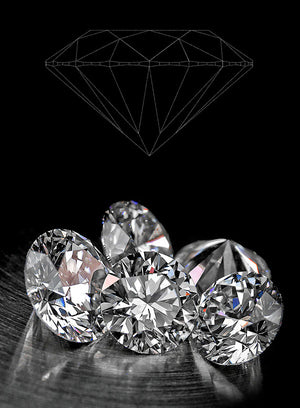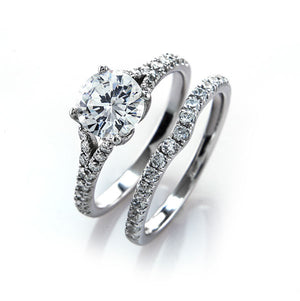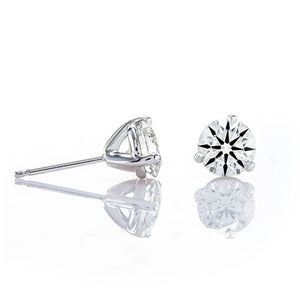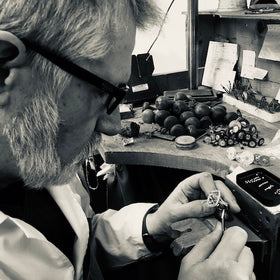
The Hearts and Arrows diamond is a "super-ideal" cut version of the traditional 57 faceted round brilliant cut.
Find Hearts & Arrows Diamonds
Cut Performance
Table of Contents
- Diamond Cut Quality - the Most Important of the 4Cs
- Cut is not the same as Diamond Shape
- Factors of Diamond Cut Grading
- The Diamond Polish Grade
- The Symmetry Grade of a Diamond
- The Proportions Grade of a Diamond
- The Overall Cut Grade of a Diamond
- Judging the Optical Symmetry of a Diamond
Diamond Cut Quality - the Most Important of the 4Cs
The Cut quality of a diamond is the most important of the 4C's of Diamond Grading, because it dictates both the volume of light return and the sparkle factor of the diamond. The overall cut grade of a diamond is determined by evaluating the individual factors of Polish, Symmetry, Proportions, and Light Performance in the case of the American Gem Society Laboratory (AGSL).
There is an additional factor known as Optical Symmetry which is not taken into account by independent gemological laboratories such as the AGSL and the Gemological Institute of America (GIA) Gem Trade Laboratory at this time. However it is a factor of diamond cut grading which is considered by upper echelon diamond cutters like Brian Gavin, who specialize in producing diamonds which exceed the normal standards of diamond grading.
Cut is not the same as Diamond Shape:
There are a lot of people in the industry who incorrectly refer to "Cut" as it applies to the "Shape" of the diamond; however it actually refers to the Cut Quality of the diamond, which takes into account the polish, symmetry and proportions of the diamond.
Each characteristic of the 4C's of Diamond Grading is represented on diamond grading reports, like those issued by the American Gem Society Laboratory (AGSL) and the Gemological Institute of America (GIA) Gem Trade Laboratory.
The AGSL lists the shape of the diamond under the heading "Shape and Style" while the GIA lists the shape under the heading "Shape and Cutting Style" and both laboratories have separate categories on the diamond grading reports which they issue for the "Cut Grade" of the diamond.
The shape of a diamond is merely the outline that defines the facet structure of the diamond, it is not a relative factor of the 4C's of Diamond Grading because it has little effect upon the visual properties of the diamond.
Perhaps the reason for the confusion among consumers and some retail jewelry store clerks, is the fact that many of the names used to describe different shapes of diamonds use the word "cut" in their description, e.g. Round Brilliant Cut, Princess Cut, Cushion Cut, Asscher Cut, Emerald Cut; however this is a reference to the shape, and the facet pattern of the diamond; and once again, the gemological laboratories do not grade the shape of the diamond, they merely reference it on the diamond grading report under the heading "Shape and Style" or "Shape and Cutting Style" while providing a separate grade for cut.
Factors of Diamond Cut Grading:
Gemological laboratories like the GIA and AGSL determine the overall cut grade of a diamond based upon the cumulative results of individual grades for polish, symmetry, and proportions. The AGSL actually considers the additional factor of light performance for diamonds graded under the parameters of their Proprietary Light Performance grading platform, which is why every Brian Gavin Signature Diamond is submitted to the AGSL for grading. The diamond grading report pictured to the left is for a 0.907 carat, G-color, VS-2 clarity, Brian Gavin Signature round ideal cut diamond. The multi-colored image of the diamond which appears on the diamond grading report represents the results of a scan of the diamond using Angular Spectrum Evaluation Technology (ASET) to measure the brightness of the diamond.
Be sure to read our article titled Visible Perfection for an in-depth explanation of what the different colors represent on an ASET image.
The Diamond Polish Grade:
The polish grade of a diamond is based upon the perfection of polish or the finish of the surface of the diamond, which is evaluated by a trained gemologist using 10x and higher magnification. The highest rating for polish from the GIA is Excellent and the highest grade from the AGSL is Ideal, the next level down is Very Good, then it drops down to Good, then Fair, then Poor.
The Symmetry Grade of a Diamond:
Symmetry grading is conducted by a trained gemologist who examines the diamond using 10x and higher magnification to determine the consistency of facet shape, size and alignment. This type of symmetry is known as "meet point symmetry" because one of the factors taken into consideration is how well the facet junctions meet up with each other.
Here again, the highest rating for polish from the GIA is Excellent and the highest grade from the AGSL is Ideal, the next level down is Very Good, then it drops down to Good, then Fair, then Poor.
The Proportions Grade of a Diamond:
The proportions grade of a diamond is determined by taking the individual sections of the diamond structure into account, and is based upon the volume of light return which is produced by different combinations of table diameter, crown angle, pavilion angle, girdle thickness, and culet size.
The proportions grading scale created by the American Gem Society Laboratory (AGSL) is based upon a scale which runs from AGS Ideal-0 which is the highest grade, down to AGS-10 Poor which is the lowest. Diamonds cut to AGS Ideal-0 proportions exhibit a significantly higher volume of light return and appear brighter than diamonds which are cut to lesser proportions, such as AGS-2 Very Good, or AGS-3 Good, and so on.
The concept behind proportions grading is easily demonstrated by thinking of the upper and lower sections of a diamond as mirrors which are designed to direct light through the diamond in a specific direction. The angle that the crown or pavilion section is cut to, will have a direct effect upon the direction that the light will move through the diamond. When the two primary reflective surfaces of the diamond are properly aligned, the volume of light reflected back out the top of the diamond is maximized.
The Overall Cut Grade of a Diamond:
The overall cut grade of the diamond is based upon the combined individual grades for polish, symmetry, proportions, and light performance in the case of the AGSL. The overall cut grade automatically defaults to the lowest grade of the factors considered during the evaluation of the diamond cut quality; thus if the individual grade for each factor is GIA Excellent, then the overall cut grade of the diamond will be GIA Excellent; and if the individual grade for each factor is AGS Ideal, then the overall cut grade of the diamond will be AGS Ideal-0.
However if the polish grade of the diamond is Very Good, and the symmetry grade is Excellent, and the proportions of the diamond are AGS Ideal Zero, then the diamond will have an overall cut grade of AGS-2 Very Good if the diamond is graded by the AGS Laboratory; the same principle holds true for diamonds graded by the GIA.
Judging the Optical Symmetry of a Diamond:
While the Polish, Symmetry, and Proportions grades of a diamond are critical components of light return and visual performance, the most important factor is the perfection of facet shape and alignment, which goes beyond the basic fundamentals of symmetry grading that gemological laboratories like the GIA and AGSL take into account.
At the present time, the gemological laboratories do not grade diamonds for optical symmetry; however it is relatively easy to grade diamonds for optical symmetry using various reflector scopes which are designed to show whether a diamond exhibits a crisp and complete pattern of hearts and arrows, like the Brian Gavin Signature round diamond pictured to the left. The pattern of hearts and arrows is the result of extremely precise facet alignment, not only within each section of facets, but actually throughout the diamond from the perspective of 360° with each facet having to be perfectly aligned with the facets above, below, and across from it in every direction.
It is important to note that the presence of a Hearts and Arrows pattern within a diamond is independent of the overall cut grade of the diamond. A diamond with an overall cut grade of GIA Excellent or AGS Ideal-0 might exhibit a crisp and complete pattern of hearts and arrows, or it might not. Likewise, a diamond might exhibit a crisp and complete pattern of hearts and arrows, but might not warrant an overall cut grade of GIA Excellent or AGS Ideal-0 because one of the factors of the overall cut grade might not be Excellent or Ideal.
By the way, the reason why the diamond appears orange in the hearts and arrows image pictured above is because the photograph is taken using an orange filter, which makes it possible to distinguish the difference between the individual sections of the diamond. The hearts appear white because they are reflecting the light off of a white colored disk which is located above the area containing the red filter...
The advantage provided by diamonds which exhibit a crisp and complete pattern of hearts and arrows as a result of being cut to a superior level of optical symmetry, is that they tend to exhibit a higher degree of light return, and produce larger flashes of light and more sparkle than diamonds cut to a lesser degree of perfection.
















